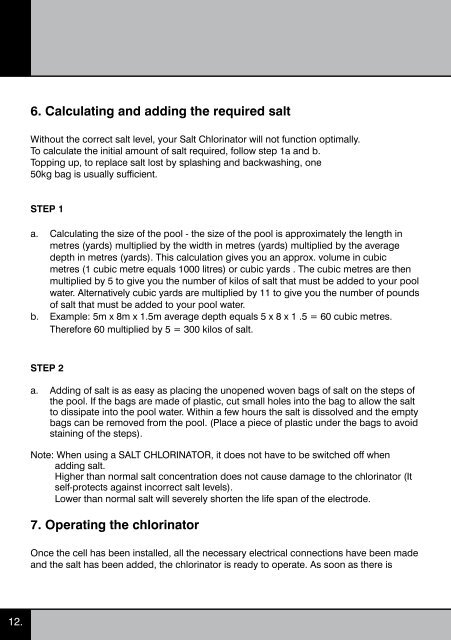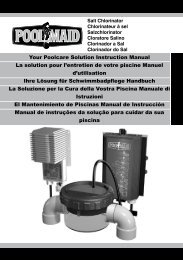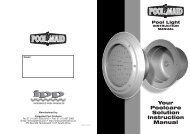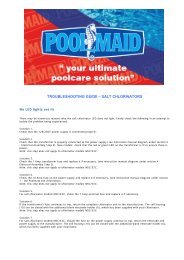Your Poolcare Solution Instruction Manual La solution ... - Poolmaid
Your Poolcare Solution Instruction Manual La solution ... - Poolmaid
Your Poolcare Solution Instruction Manual La solution ... - Poolmaid
You also want an ePaper? Increase the reach of your titles
YUMPU automatically turns print PDFs into web optimized ePapers that Google loves.
1 .<br />
6. Calculating and adding the required salt<br />
Without the correct salt level, your Salt Chlorinator will not function optimally.<br />
To calculate the initial amount of salt required, follow step 1a and b.<br />
Topping up, to replace salt lost by splashing and backwashing, one<br />
50kg bag is usually sufficient.<br />
STEP 1<br />
a.<br />
b.<br />
STEP 2<br />
a.<br />
Calculating the size of the pool - the size of the pool is approximately the length in<br />
metres (yards) multiplied by the width in metres (yards) multiplied by the average<br />
depth in metres (yards). This calculation gives you an approx. volume in cubic<br />
metres (1 cubic metre equals 1000 litres) or cubic yards . The cubic metres are then<br />
multiplied by 5 to give you the number of kilos of salt that must be added to your pool<br />
water. Alternatively cubic yards are multiplied by 11 to give you the number of pounds<br />
of salt that must be added to your pool water.<br />
Example: 5m x 8m x 1.5m average depth equals 5 x 8 x 1 .5 = 60 cubic metres.<br />
Therefore 60 multiplied by 5 = 00 kilos of salt.<br />
Adding of salt is as easy as placing the unopened woven bags of salt on the steps of<br />
the pool. If the bags are made of plastic, cut small holes into the bag to allow the salt<br />
to dissipate into the pool water. Within a few hours the salt is dissolved and the empty<br />
bags can be removed from the pool. (Place a piece of plastic under the bags to avoid<br />
staining of the steps).<br />
Note: When using a SALT CHLORINATOR, it does not have to be switched off when<br />
adding salt.<br />
Higher than normal salt concentration does not cause damage to the chlorinator (It<br />
self-protects against incorrect salt levels).<br />
Lower than normal salt will severely shorten the life span of the electrode.<br />
7. Operating the chlorinator<br />
Once the cell has been installed, all the necessary electrical connections have been made<br />
and the salt has been added, the chlorinator is ready to operate. As soon as there is







